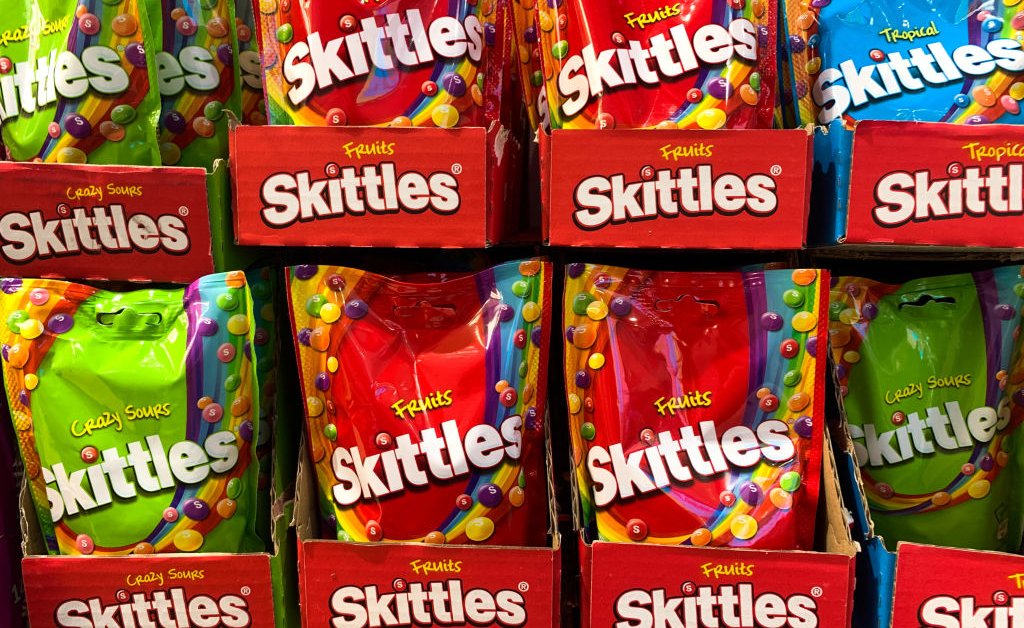
California legislators are contemplating a invoice that would doubtlessly ban the sale of Skittles and several other different well-liked snacks as a result of analysis exhibits a few of the chemical compounds in them are poisonous.
The invoice would pressure corporations to alter the recipes of some beloved sweets, together with M&Ms and Nerds sweet, or to take drastic measures and pull their objects from the California market. It’s unclear if the invoice will achieve momentum, but when handed, California would develop into the primary state to ban particular components in meals.
The ban would apply to 5 chemical compounds—crimson dye No. 3, titanium dioxide, potassium bromate, brominated vegetable oil and propylparaben—that are usually used as preservatives, dyes and texture enhancers. The chemical compounds are permitted for consumption within the U.S. by the Meals and Drug Administration (FDA), however are all banned in Europe on account of security issues.
A number of the invoice’s supporters imagine that federal laws have neglected scientific analysis linking the chemical compounds to illnesses together with most cancers, neurological issues and behavioral points in kids.
Right here’s what to know.
What are the intentions behind the invoice?
The meeting member behind the invoice, Jesse Gabriel, confesses that he loves sweet, particularly Skittles, and that he undoubtedly wouldn’t assist a invoice to ban Skittles. That’s not the invoice’s intention, he tells TIME. “This invoice is about getting corporations to alter their recipes,” Gabriel says. “They nonetheless promote Skittles in Europe. They only eliminated titanium dioxide, which is a really harmful ingredient.”
As a father of three younger kids, Gabriel worries about components like these chemical compounds, citing dangers for kids’s improvement, reproductive points and issues over carcinogens and harm to the immune system.
“A part of the explanation we selected [these five] is as a result of for every of them, there’s a available safer different,” Gabriel says.
Opposition towards the invoice has been strongest from commerce associations, together with the American Chemical Business, the American Bakers Affiliation and the California Chamber of Commerce. In a letter to the California Meeting’s well being committee, 11 teams wrote, “this measure usurps the great meals security and approval system for these 5 components and predetermines ongoing evaluations.”
What are the potential dangers of those chemical compounds?
A lot of the analysis round these chemical compounds confirmed potential well being dangers on animals, which scientists imagine can apply to people too. In 1990, the FDA banned the usage of crimson dye No. Three in cosmetics, however continues to allow it in hundreds of meals objects. Potassium Bromate has been banned within the U.Okay., India, Brazil, Canada and throughout Europe, over fears that it could possibly be carcinogenic. Though the entire chemical compounds proposed within the invoice are FDA permitted, a few of them, like propylparaben and titanium dioxide, are restricted to make up 1% or much less of the meals merchandise’s composition.
“Numerous issues on that checklist have been proven to doubtlessly have dangerous penalties,” Carolyn Slupsky, a vitamin professor on the College of California, Davis, tells TIME, including that though we didn’t find out about most of the dangers when the chemical compounds first entered the market, extra info is obtainable now.
“The federal government must be keen to assist fund analysis into these chemical compounds that individuals need to put into the meals provide, or which can be already within the meals provide, and begin taking a look at it extra fastidiously,” Slupsky says.
The FDA classifies many chemical components as GRAS, or “Typically Acknowledged as Secure,” allowing their use. Gabriel criticizes the FDA’s evaluate course of, claiming that many of the chemical compounds had been by no means independently reviewed or had been final reviewed many years in the past. The FDA’s course of for reviewing meals components entails gathering information straight from producers and rejecting or approving the components for particular makes use of, however some researchers assume the decades-old information on sure components must be re-evaluated.
“These corporations are going to should put a few of their cash into discovering alternate methods to protect their product,” Slupsky says. “Plenty of it’s only for [food] coloration[ing].”
Current analysis has additionally raised alarms that extremely processed meals improve the danger of varied well being points, together with weight problems, hypertension, diabetes and dementia. “It’s not simply that everyone sits on their butts and eats chips,” Slupsky says. “I believe that we have to begin wanting extra fastidiously on the varieties of meals that we’re consuming.”
Gabriel is hopeful that as corporations start to acknowledge the social accountability they owe customers, commerce associations may also face strain to push for brand new alternate options. “If this passes, it can actually have an effect past California,” he says. “Nobody’s going to stroll away from the California market; it’s too massive.”
The invoice will enter committee hearings subsequent month, starting April 11.
Extra Should-Reads From TIME



